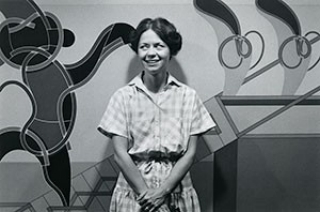Born 1940, Chicago, Illinois
When Barbara Rossi first exhibited her work in 1970, she was a natural fit among a nascent group of artists known today as the Chicago imagists. Noted for their irreverent humor, meticulous craftsmanship, and surrealist leanings, Rossi and her colleagues practiced a unique form of pop art throughout the 1970s. They drew inspiration from popular images, vernacular objects, and non-Western art—an ecumenical attitude fostered by two seminal teachers, Whitney Halstead and Ray Yoshida, at the School at the Art Institute of Chicago.
Like fellow artist Jim Nutt, who was inspired by graphics on pinball machines, Rossi experimented with reverse paintings on Plexiglas between about 1972 and 1977. Yet unlike Nutt’s cartoonishly deformed figures, Rossi’s compositions never quite cohere into a recognizable body. Rather, they evoke flesh, with heaving, swollen shapes of various tones that resemble fingers, feet, or a phallus. These free-form, interlocking parts derive from her improvised drawings, which she adapted as guides for her paintings. Because painting the back of glass does not allow for revision, this technique requires intense concentration and precise application of the flat color, lines, and dots. In a work like Rose Rock such care is evident in the pinhead-sized dots that make up the crisscrossing background pattern and in delicate accents around selected contours. Like dazzling beads, these dots also reflect light and cast shadows through the Plexiglas, intensifying an optical experience that already borders on the otherworldly.
In these early years of her career Rossi also combined techniques to explore the relationship between materiality and internal states of feeling. Male of Sorrows comprises four impressions of an etching the artist based on a fifteenth-century color woodcut of the crucified Christ, which have been printed on satin, quilted together in a block, and framed with a border of downy feathers. Here, the devotional function of its art historical reference is matched by the artistic process: while the pierced, stitched cloth resonates with Christ’s visceral suffering, Rossi’s careful handling and seductive textures invite the intimacy of touch that elicits a beholder’s emotional connection to the object of religious wonder.
Elaine Yau
Adrian, Dennis, and Carol Becker. Barbara Rossi: Selected Works, 1967–1990. Chicago: Renaissance Society at the University of Chicago, 1991.
Warren, Lynne, et al. Chicago Imagists. Madison, WI: Madison Museum of Contemporary Art, 2011.
